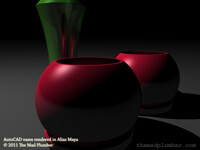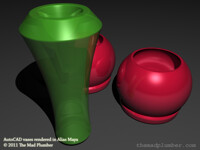
Thank you very much for visiting. Advanced criticism and professional advice are strongly encouraged.
Inspired by an earlier comment where a user suggested employing mental ray rendering for my three-dimensional models, I had composed a new Alias Maya scene based on his suggestion. This image featured in this submission is a rendering of this scene, featuring a vase that was originally modeled in AutoCAD and several NURBS spheres that were built from scratch in Alias Maya. Also, I experimented in adding a fractal texture to the Phong material used for the floor.
This is one of five renderings I have made of this scene. This and the other four renderings will eventually be uploaded to my website.
A source of frustration was that I found mental ray rendering to be the most time consuming of the rendering methods available. Because of the lucrative amount of time it took just to render one image, I rendered these shots a small piece at a time. It is important to save render progress between renders; if you push the wrong button, you may lose all your progress and be forced to start over.
In the meantime, I have been learning a little more about Maya through experimentation and am feeling more comfortable about modeling objects from scratch within it. The ability to render scenes in pieces as opposed to all at once takes a load of weight off my computer.
I hope to entertain watchers with more compelling three-dimensional models in the future. Thanks for visiting and have a safe and wonderful day.
PROJECT #358
Inspired by an earlier comment where a user suggested employing mental ray rendering for my three-dimensional models, I had composed a new Alias Maya scene based on his suggestion. This image featured in this submission is a rendering of this scene, featuring a vase that was originally modeled in AutoCAD and several NURBS spheres that were built from scratch in Alias Maya. Also, I experimented in adding a fractal texture to the Phong material used for the floor.
This is one of five renderings I have made of this scene. This and the other four renderings will eventually be uploaded to my website.
A source of frustration was that I found mental ray rendering to be the most time consuming of the rendering methods available. Because of the lucrative amount of time it took just to render one image, I rendered these shots a small piece at a time. It is important to save render progress between renders; if you push the wrong button, you may lose all your progress and be forced to start over.
In the meantime, I have been learning a little more about Maya through experimentation and am feeling more comfortable about modeling objects from scratch within it. The ability to render scenes in pieces as opposed to all at once takes a load of weight off my computer.
I hope to entertain watchers with more compelling three-dimensional models in the future. Thanks for visiting and have a safe and wonderful day.
PROJECT #358
themadplumber.com
Category Artwork (Digital) / Still Life
Species Unspecified / Any
Size 1024 x 768px
File Size 371.7 kB
yep, it is one of my wallpaper =D, the vase look like the pot that i got for the GO chess.
here is a photo for the GO chess
http://1.bp.blogspot.com/_t_-vE2UGW...../Photo0917.jpg
here is a photo for the GO chess
http://1.bp.blogspot.com/_t_-vE2UGW...../Photo0917.jpg
Okay, I had to check out my scene file to answer your question. The fractal material exists as a projection image related to the "matPlane" material that I applied to the floor geometry. When you examine the "fractal1" fractal node, you can see the pattern it is based on which appears to be a grayscale pattern. The fractal material is something that Maya's library provided to me. I selected the "matPlane" node's bump map attribute and selected the fractal material to apply to it.
I appreciate your interest in this work as well as the advice your relayed earlier. With my knowledge of these rendering methods, it could equate to better renderings when I revisit some of my older models. The increased rendering times can be somewhat cumbersome, but amazingly the results are faster and better than AutoCAD.
Thanks for visiting!
I appreciate your interest in this work as well as the advice your relayed earlier. With my knowledge of these rendering methods, it could equate to better renderings when I revisit some of my older models. The increased rendering times can be somewhat cumbersome, but amazingly the results are faster and better than AutoCAD.
Thanks for visiting!

 FA+
FA+









Comments